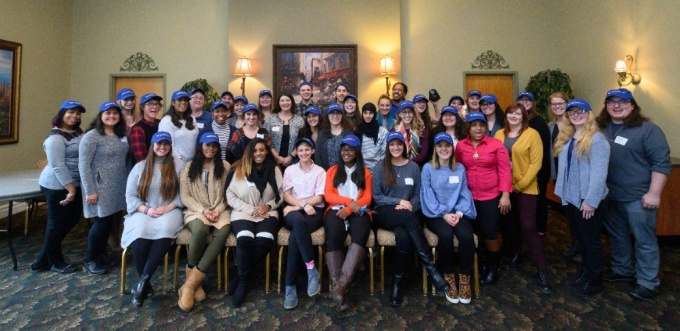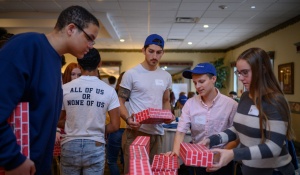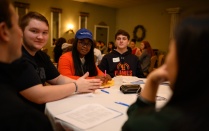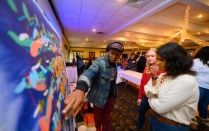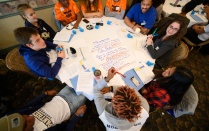Challenge 2 Change Growing and Making a Difference
Over 40 MSW students participated in the Challenge 2 Change event. They are as follows, left to right: Back Row: Emma Hesch, Sara Campbell, Christopher Owen, Dominique Brown, Jessica Watt, Michael Korzelius, Danial Kahn, Thomas Griffith, Amelia Stachowiak. Middle Row: Ta-Tanisha Palmer, Nicole Capozziello, Grace Ravines, Karishma Khemraj, Ashley Washington, Megan Krebs, Annahita Ball, Emily Sacco, Melina Ciotta, Samantha Ebeling, Nyala Ahmed, Sydney Lyons, Julianne Reese, Leah Ingraham, Kayla Savitt, Jessica Mencia, Jenna Reed, Kat Wilson, Rayna Geller, Candra Skrzypek, Amanda Sabins, Sean Brosius. Bottom Row: Emmy Brady, Octavia Dawkins, MyKole Gates, Rave Glynn, Juliana Mowatt, Carmann Benedetto, Samantha Lee, Linette Moses.
High school and MSW students gain from open dialogue
By Bert Gambini and Jana Eisenberg
More than 250 high school youths had an opportunity to become thoughtful leaders in the areas of racial understanding and social justice at the fourth annual Challenge 2 Change Summit, held Nov. 21 at Banchetti by Rizzo.
The summit, hosted by the Sweet Home Central School District, was co-led by Annahita Ball, assistant professor in the UBSSW. Ball’s involvement with Challenge 2 Change began in 2014, when administrators and staff in the Amherst Central School District approached her on how to build programming centered on diversity. Challenge 2 Change is modeled after a similar youth program in Missouri; it developed as a response to a fatal shooting and the civil unrest that ensued in Ferguson, Missouri in 2014.
“Challenge 2 Change speaks to my passion for inclusive learning environments and is a great opportunity for area high school students and students in the School of Social Work,” noted Ball.
The program has grown every year, receiving more interest and engaging more schools and districts in its hands-on work to address important issues that teens face in high school, including bias and hate. And this year, over 40 MSW student volunteers participated as facilitators in the full-day summit.
During the summit, UBSSW students facilitated small group dialogues with high school students on matters of diversity, privilege and oppression. The objective was to provide high school students with a forum to express their feelings and concerns. Based on intergroup dialogue, Challenge 2 Change has been a successful vehicle for high school students to responsibly and respectfully discuss difficult issues in an emotionally safe environment.
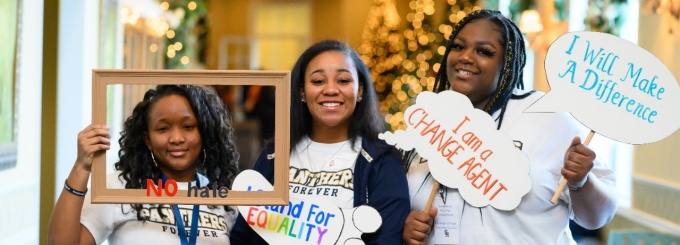
Local high school students took part in the annual Challenge 2 Change, hosted by the Sweet Home Central School District.
This year, the organizers tried something new: a visual representation of how they might be able to address some of these issues. “One of the activities that groups did with the MSW students was to take a ‘brick’ and write a brief message about what hate and bias looks like in their school,” said Ball. “In the morning, they built the bricks into a wall. One example I remember was, ‘making fun of the food I eat.’ After lunch they talked about things they could do to create change.”
The lessons gained from Challenge 2 Change are mutually beneficial to both the high school participants and the graduate school facilitators in the SSW.
“These learning opportunities for our graduate students are a chance for them to apply what they’re learning in the classroom to an actual community setting,” said Ball. “This experience teaches them how to be flexible and adapt to their current context so they’re better prepared when it’s time for them to enter the work force.”
Ball added that the program has grown to a point where the stakeholders need to decide what to do next. “We’ve formed a steering committee made up of members from UB, the school districts and the community,” she said. “We want to expand programming beyond the once-a-year summit—do [a] leadership retreat for kids, engage adults in their lives and give teachers more.”
Students used "bricks" to identify issues, and built a wall using them. At the end of the day, they deconstructed the wall, and referenced the messages on the bricks to identify a change they could make.
To do that, they need to consider funding sources. And to do that, they need to provide evidence of success and value. “My grad students and I have done preliminary evaluation of last year’s summit, and we will be publishing a paper,” said Ball. “We’re still studying, but the kids reported positive changes in intergroup empathy, critical consciousness and motivation for action—and that’s after only one day of programming.”
Oh, and the brick wall? "At the end of the day, everybody tore down their walls," said Ball. "Then they wrote on the opposite side of the brick an action they will take when they get back to school to create change."
Graduate student volunteers from the School of Social Work facilitated small group dialogue with the high school students on the issues of diversity, privilege and oppression.
Edreys Wajed, a local artist, educator and musician, talks about a "live" painting he created with student attendees at the Challenge 2 Change summit.
High school students learned the vocabulary of oppression in small groups facilitated by UBSSW students.
